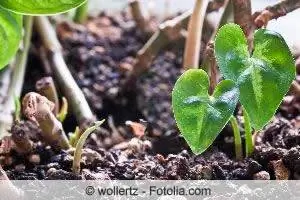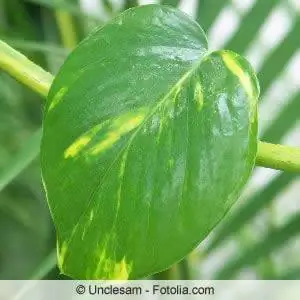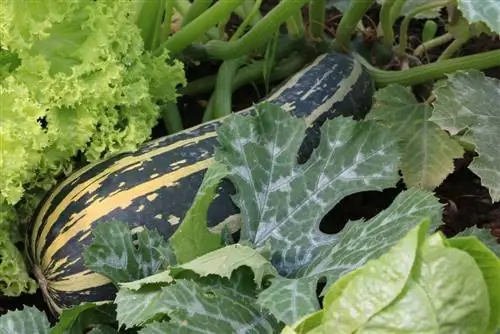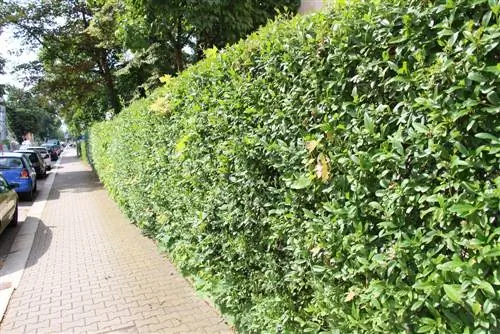- Author admin [email protected].
- Public 2023-12-17 03:39.
- Last modified 2025-01-24 12:45.
If rubber trees etc. have numerous aerial roots, they can not only become a visual nuisance, but also a tripping hazard. At this point at the latest, appropriate measures should be taken to redirect the aerial roots in a meaningful way - because cutting them off is neither necessary nor recommended. If you don't want to let it get to that point, you can reduce the tendency to aerial roots in rubber trees, monsteras and philodendrons right from the start. Interested hobby gardeners will find out how to do this below.
Function of aerial roots
Some plants, such as the Monstera, the Philodendron and the rubber tree, tend to develop aerial roots. If these are short and barely protrude from the trunk, they don't cause much of a problem. The situation is different if they grow beyond the pot and become a tripping hazard or become anchored in the shoots of other plants. The temptation to simply cut off the aerial roots is then quite great. However, this approach does not benefit the plants. Although they do not usually die immediately, they are significantly weakened or encouraged to develop even more aerial roots.
The reason for this lies in the functions of the above-ground roots. These ensure stability, are climbing aids and thus make it easier for the plants to grow in height. In addition, they are able to absorb moisture and nutrients - so they also play a crucial role in supplying the plant. Their removal is correspondingly damaging.
Prevention
So that cutting off the aerial roots is not even necessary, it makes sense to take good care of rubber trees etc. This includes the following measures:
- Provide the plant with a climbing aid, such as a moss stick or a trellis
- Water and spray sufficiently, also wipe the leaves regularly with a damp cloth
- Fertilize at regular intervals
- If necessary, plant or repot annually in fresh substrate
If monstera or philodendron is given everything it needs for he althy growth in this way, the tendency to form aerial roots is effectively reduced.
Cut

If there is an increasing number of aerial roots, the conditions should first be checked. Runners often form more often if the substrate is too dry or does not contain enough nutrients. The plants then try to compensate for the resulting deficit through their aerial roots. The same applies if the plant lacks the stability to grow in height.
If you notice a sudden, very strong formation of aerial roots, you can often counteract this by increasing the moisture and nutrient supply. In addition to improving the culture conditions, short aerial roots may be removed with a sharp knife. The shorter these are, the lower the stress on the plant.
The procedure is as follows:
- A sharp knife is thoroughly cleaned and ideally disinfected.
- Gloves should be worn to protect against emerging plants. It is also beneficial to cover the ground under the plant.
- The aerial roots are cut off individually and carefully from top to bottom directly on the trunk.
- To avoid excessive sap leakage, the cut surface can be dabbed with a hot, damp cloth or dusted with charcoal powder.
Cutting off should only be done when the aerial roots are a few centimeters long. If there are already numerous longer runners, cutting them off is no longer recommended. The plant would suffer too much. In addition to removing the aerial roots, the causes must also be eliminated. If the supplying shoots are cut off even though the water and nutrient supply is still insufficient, the plant will die and will try to compensate for the deficit with even more aerial roots. This case also occurs if there is a lack of stability.
Stabilization
In larger and older plants, it often happens that aerial roots are formed for stabilization. If there is no suitable base, the number of unwanted roots increases steadily and anchors themselves wherever they find support. This can be counteracted quite easily by providing a climbing aid. The moss stick mentioned above is ideal. The rough and slightly uneven surface offers the stabilizing aerial roots an optimal base. This hold is also visually appealing.
Alternatively, thin trunks or straight branches with bark, sticks or scaffolding can be used. Longer aerial roots that already exist can also be attached later to eliminate tripping hazards or to make the overall look more decorative.
Tip:
When attaching long roots, make sure that they are attached very carefully and gently. The roots break easily and are therefore quickly damaged.
Supply
Since aerial roots develop especially when the plant is too dry and the supply from the substrate is insufficient, increasing the amount of watering can limit growth. In addition, the plant should be sprayed several times a week. Wiping the leaves with a damp cloth also improves the absorption capacity and thus the supply.
If there are already numerous aerial roots, these can also be used for supply. There are various options to choose from. For example, it is a good idea to attach a water container to the plant pot and let the aerial roots grow in it. It should be noted, however, that the aerial roots convert into normal roots over time. This makes redirection easier.
Instead of concealing a separate water container specifically for the roots, the formation of aerial roots and their supply can also be used as an exotic decoration. For this purpose, it is recommended to let the aerial roots grow in an aquarium. A glass with aquatic plants also gets a special touch thanks to the roots that creep in.
A nice side effect of the roots is their cleansing function on the water. Substances that are harmful to the aquarium inhabitants are absorbed by the rubber tree, philodendron and monstera and used to supply nutrients. The plants therefore act as an additional filter.
Redirect

Since the aerial roots of rubber trees etc. can transform into ordinary roots if there is sufficient moisture, there is another option available. Here too, the supply to the plant is improved and the growth of the aerial roots is reduced in the long term. We're talking about redirecting or planting the roots.
This is done as follows:
- If the plant has long aerial roots that already reach to the substrate, the plant should be repotted as soon as possible.
- To ensure sufficient supply, the old substrate must be completely removed. To do this, it is recommended to rinse any remaining soil from the roots.
- When choosing a new planter, make sure that it should only be one or two sizes larger than the previous one.
- The bottom of the pot is covered with suitable substrate and the root ball is inserted. The aerial roots are led down and into the planter so that they are covered by as much soil as possible, but are still not under tension.
- Finally, the pot is filled with soil and watered thoroughly. Additional fastening is not necessary for the aerial roots.
After a short time, the aerial roots form fine hairs and transform underground into normal plant roots. In this way they provide stability in the substrate and serve to supply the plant.
Conclusion
Although it is possible to cut off very short aerial roots of Monstera, Philodendron and rubber trees early, these shoots fulfill useful functions and are often signs of deficiency conditions. It is therefore advisable to prevent them through good care and cultivation conditions or to use longer aerial roots to your advantage. There are several options available for this, so that the right variant can be found for every decorative requirement and every preference.






